Economics for Business: Analysis of Stable Equilibrium in Australia
VerifiedAdded on 2020/04/01
|9
|1462
|331
Report
AI Summary
This report provides an analysis of stable equilibrium within the Australian economy, examining both microeconomic and macroeconomic perspectives. It begins by defining stable equilibrium, referencing market equilibrium and the AD-AS model. The report then assesses the current state of the Australian economy, highlighting the significance of key macroeconomic indicators such as GDP and inflation rates, demonstrating the economy's stability. It further explores the necessity of government intervention, detailing the use of monetary and fiscal policies, including automatic and discretionary stabilizers, to maintain economic stability and manage fluctuations. The report concludes by emphasizing the importance of government intervention in ensuring the ongoing stability of the Australian economy, particularly during business cycle phases. The report references relevant economic literature to support its arguments.
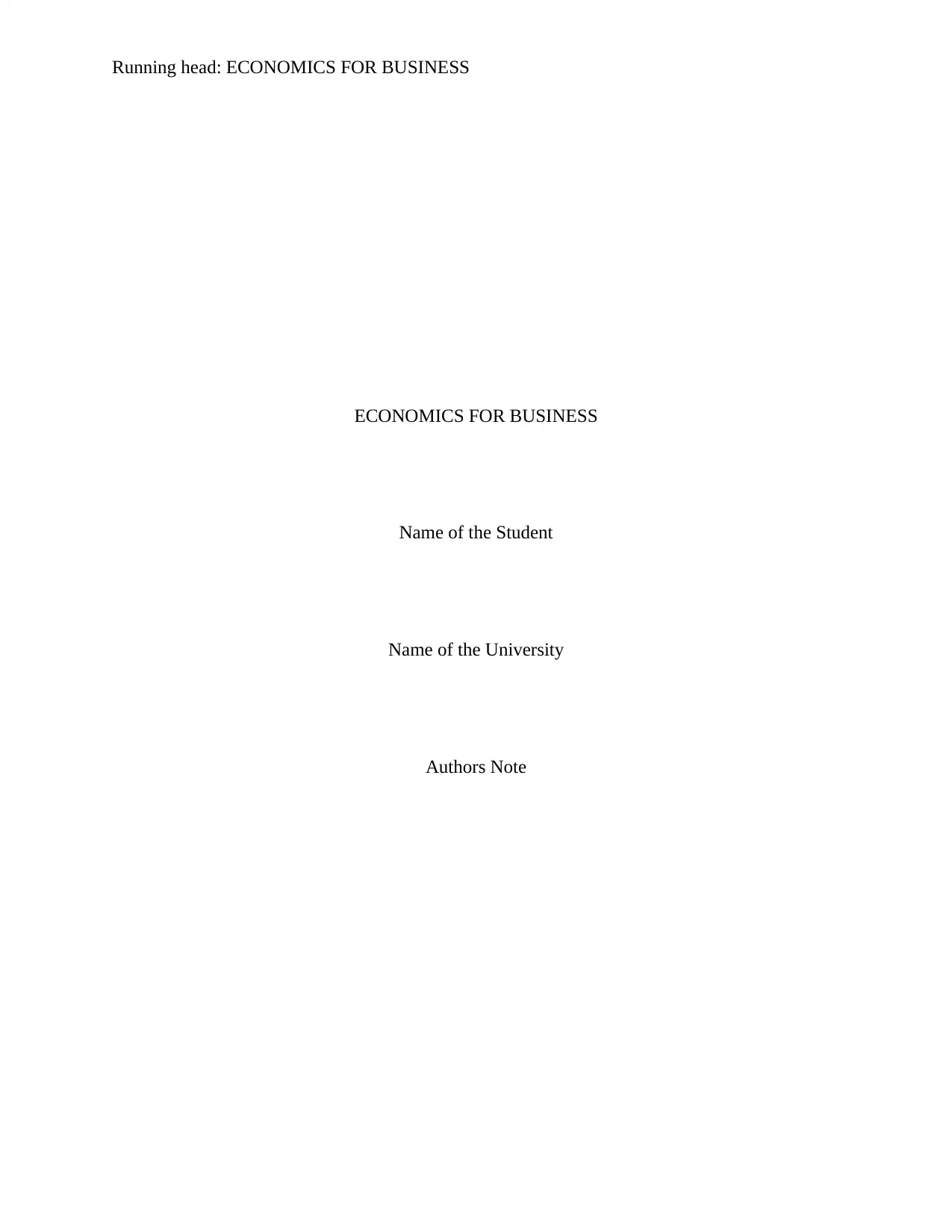
Running head: ECONOMICS FOR BUSINESS
ECONOMICS FOR BUSINESS
Name of the Student
Name of the University
Authors Note
ECONOMICS FOR BUSINESS
Name of the Student
Name of the University
Authors Note
Paraphrase This Document
Need a fresh take? Get an instant paraphrase of this document with our AI Paraphraser
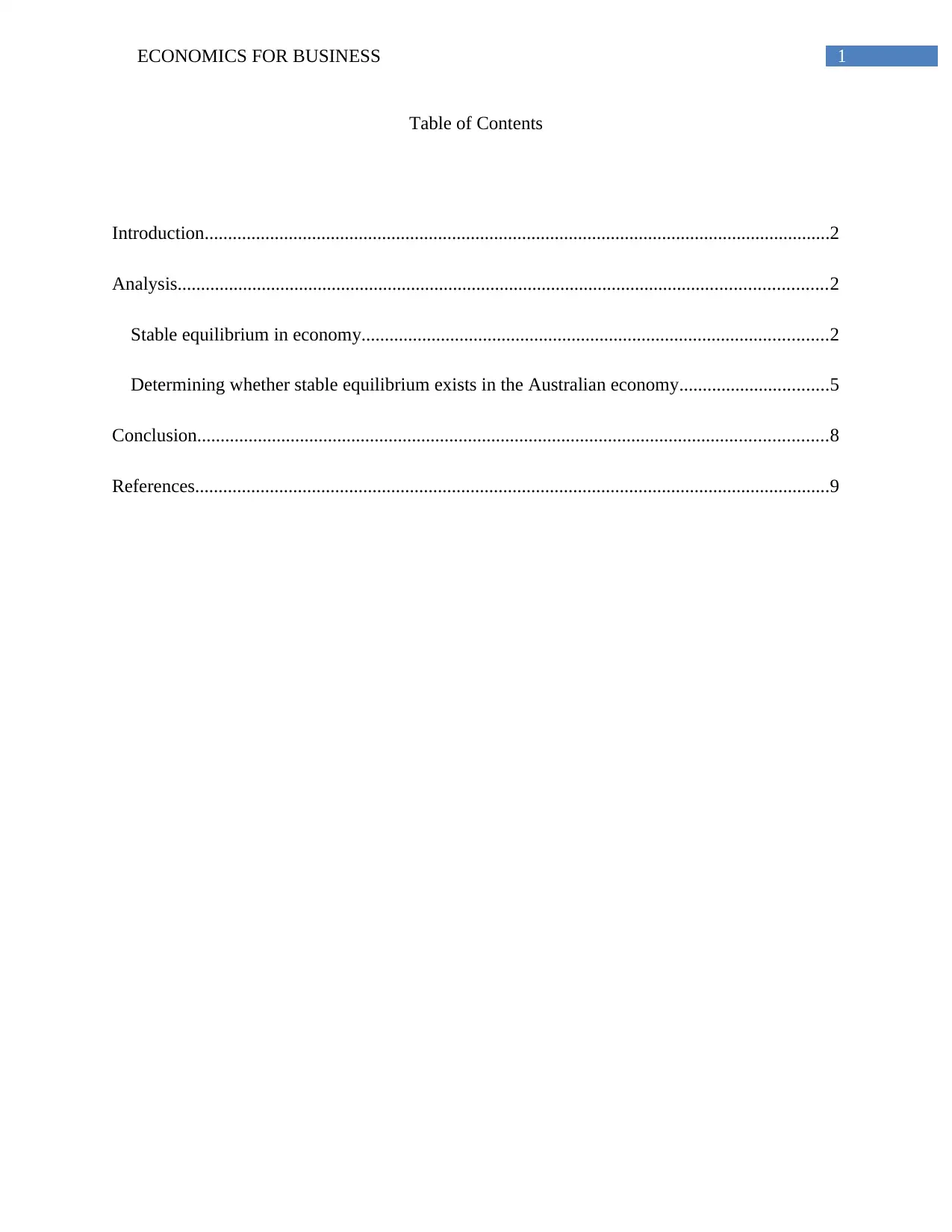
1ECONOMICS FOR BUSINESS
Table of Contents
Introduction......................................................................................................................................2
Analysis...........................................................................................................................................2
Stable equilibrium in economy....................................................................................................2
Determining whether stable equilibrium exists in the Australian economy................................5
Conclusion.......................................................................................................................................8
References........................................................................................................................................9
Table of Contents
Introduction......................................................................................................................................2
Analysis...........................................................................................................................................2
Stable equilibrium in economy....................................................................................................2
Determining whether stable equilibrium exists in the Australian economy................................5
Conclusion.......................................................................................................................................8
References........................................................................................................................................9
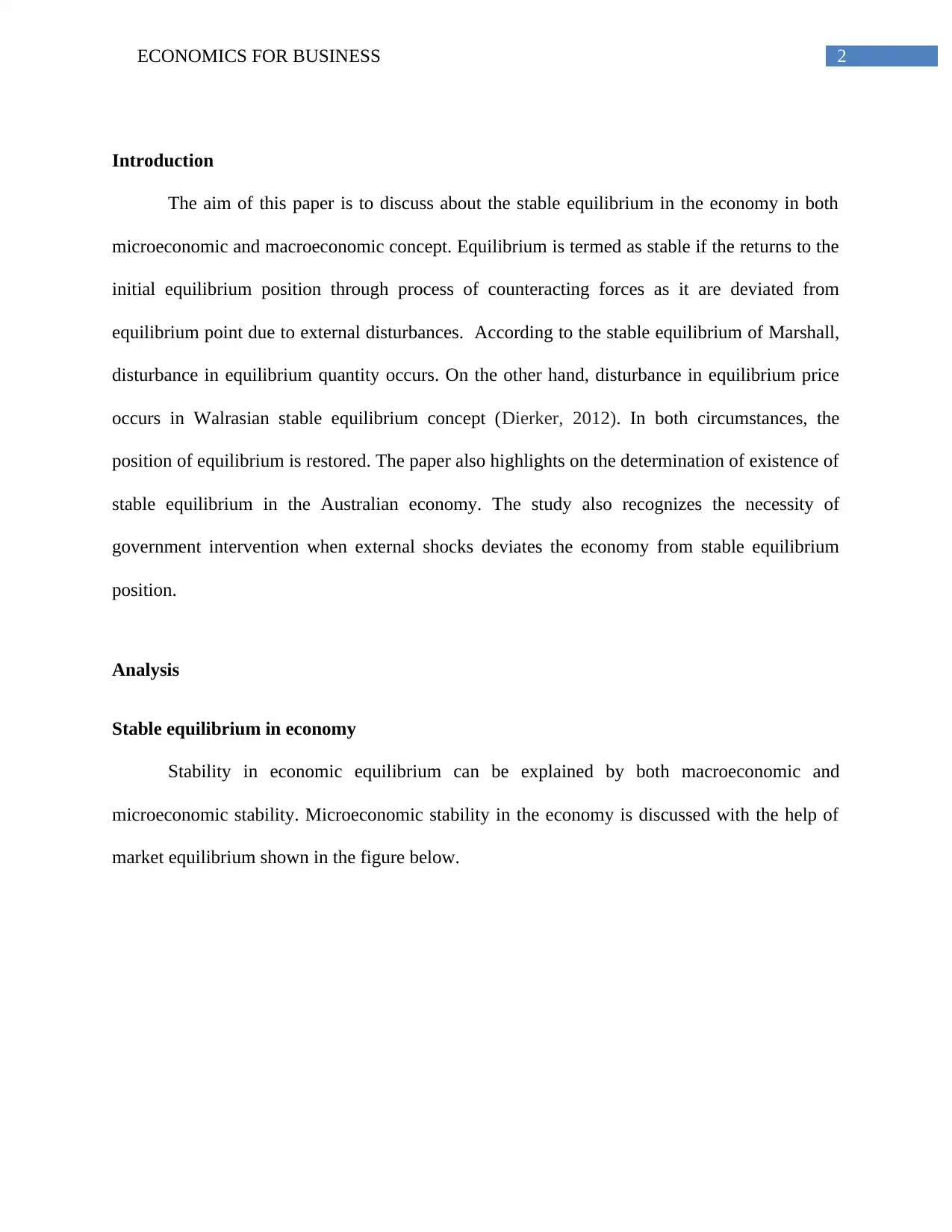
2ECONOMICS FOR BUSINESS
Introduction
The aim of this paper is to discuss about the stable equilibrium in the economy in both
microeconomic and macroeconomic concept. Equilibrium is termed as stable if the returns to the
initial equilibrium position through process of counteracting forces as it are deviated from
equilibrium point due to external disturbances. According to the stable equilibrium of Marshall,
disturbance in equilibrium quantity occurs. On the other hand, disturbance in equilibrium price
occurs in Walrasian stable equilibrium concept (Dierker, 2012). In both circumstances, the
position of equilibrium is restored. The paper also highlights on the determination of existence of
stable equilibrium in the Australian economy. The study also recognizes the necessity of
government intervention when external shocks deviates the economy from stable equilibrium
position.
Analysis
Stable equilibrium in economy
Stability in economic equilibrium can be explained by both macroeconomic and
microeconomic stability. Microeconomic stability in the economy is discussed with the help of
market equilibrium shown in the figure below.
Introduction
The aim of this paper is to discuss about the stable equilibrium in the economy in both
microeconomic and macroeconomic concept. Equilibrium is termed as stable if the returns to the
initial equilibrium position through process of counteracting forces as it are deviated from
equilibrium point due to external disturbances. According to the stable equilibrium of Marshall,
disturbance in equilibrium quantity occurs. On the other hand, disturbance in equilibrium price
occurs in Walrasian stable equilibrium concept (Dierker, 2012). In both circumstances, the
position of equilibrium is restored. The paper also highlights on the determination of existence of
stable equilibrium in the Australian economy. The study also recognizes the necessity of
government intervention when external shocks deviates the economy from stable equilibrium
position.
Analysis
Stable equilibrium in economy
Stability in economic equilibrium can be explained by both macroeconomic and
microeconomic stability. Microeconomic stability in the economy is discussed with the help of
market equilibrium shown in the figure below.
⊘ This is a preview!⊘
Do you want full access?
Subscribe today to unlock all pages.

Trusted by 1+ million students worldwide
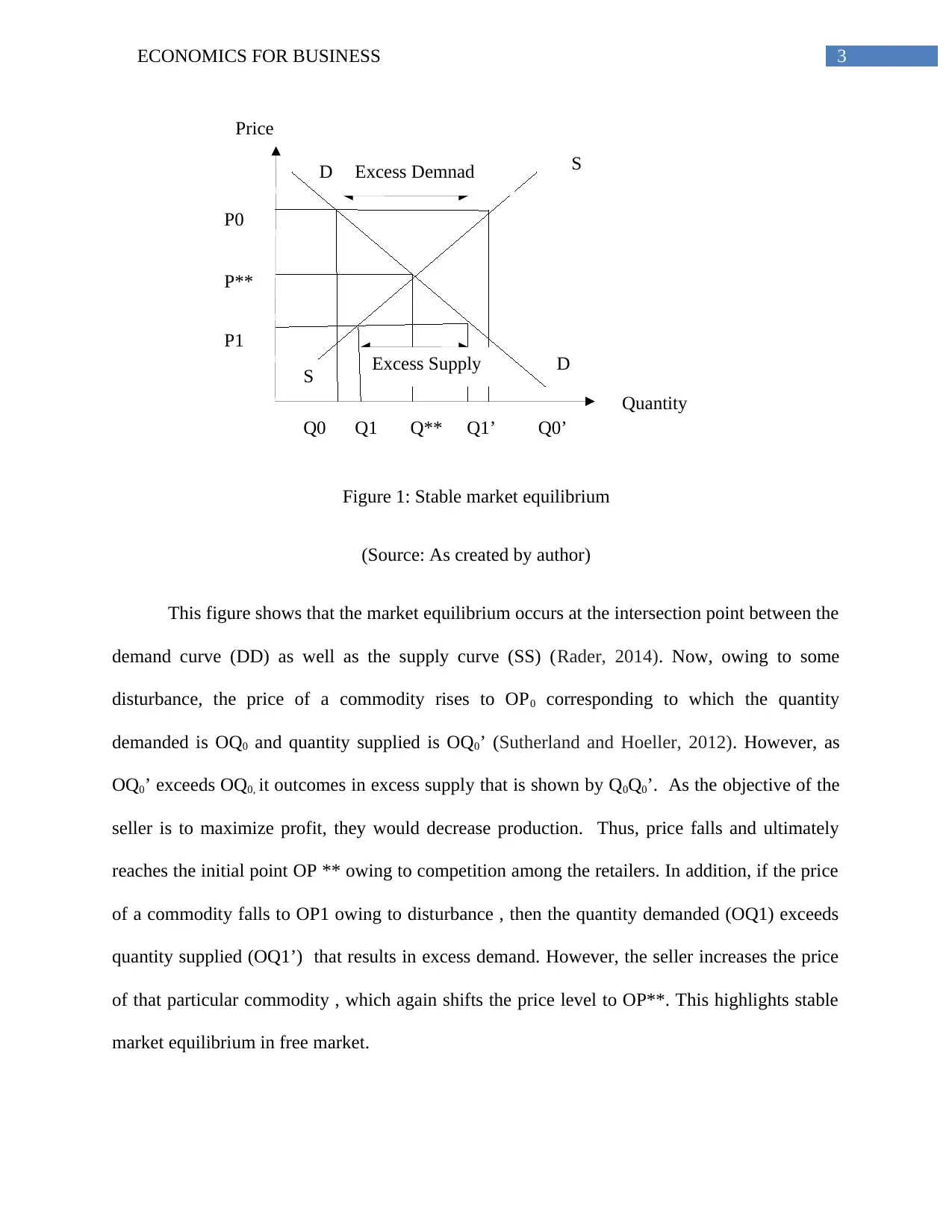
3ECONOMICS FOR BUSINESS
Quantity
Price
S
S D
D
P**
P0
P1
Q**Q1 Q0’Q0 Q1’
Excess Demnad
Excess Supply
Figure 1: Stable market equilibrium
(Source: As created by author)
This figure shows that the market equilibrium occurs at the intersection point between the
demand curve (DD) as well as the supply curve (SS) (Rader, 2014). Now, owing to some
disturbance, the price of a commodity rises to OP0 corresponding to which the quantity
demanded is OQ0 and quantity supplied is OQ0’ (Sutherland and Hoeller, 2012). However, as
OQ0’ exceeds OQ0, it outcomes in excess supply that is shown by Q0Q0’. As the objective of the
seller is to maximize profit, they would decrease production. Thus, price falls and ultimately
reaches the initial point OP ** owing to competition among the retailers. In addition, if the price
of a commodity falls to OP1 owing to disturbance , then the quantity demanded (OQ1) exceeds
quantity supplied (OQ1’) that results in excess demand. However, the seller increases the price
of that particular commodity , which again shifts the price level to OP**. This highlights stable
market equilibrium in free market.
Quantity
Price
S
S D
D
P**
P0
P1
Q**Q1 Q0’Q0 Q1’
Excess Demnad
Excess Supply
Figure 1: Stable market equilibrium
(Source: As created by author)
This figure shows that the market equilibrium occurs at the intersection point between the
demand curve (DD) as well as the supply curve (SS) (Rader, 2014). Now, owing to some
disturbance, the price of a commodity rises to OP0 corresponding to which the quantity
demanded is OQ0 and quantity supplied is OQ0’ (Sutherland and Hoeller, 2012). However, as
OQ0’ exceeds OQ0, it outcomes in excess supply that is shown by Q0Q0’. As the objective of the
seller is to maximize profit, they would decrease production. Thus, price falls and ultimately
reaches the initial point OP ** owing to competition among the retailers. In addition, if the price
of a commodity falls to OP1 owing to disturbance , then the quantity demanded (OQ1) exceeds
quantity supplied (OQ1’) that results in excess demand. However, the seller increases the price
of that particular commodity , which again shifts the price level to OP**. This highlights stable
market equilibrium in free market.
Paraphrase This Document
Need a fresh take? Get an instant paraphrase of this document with our AI Paraphraser
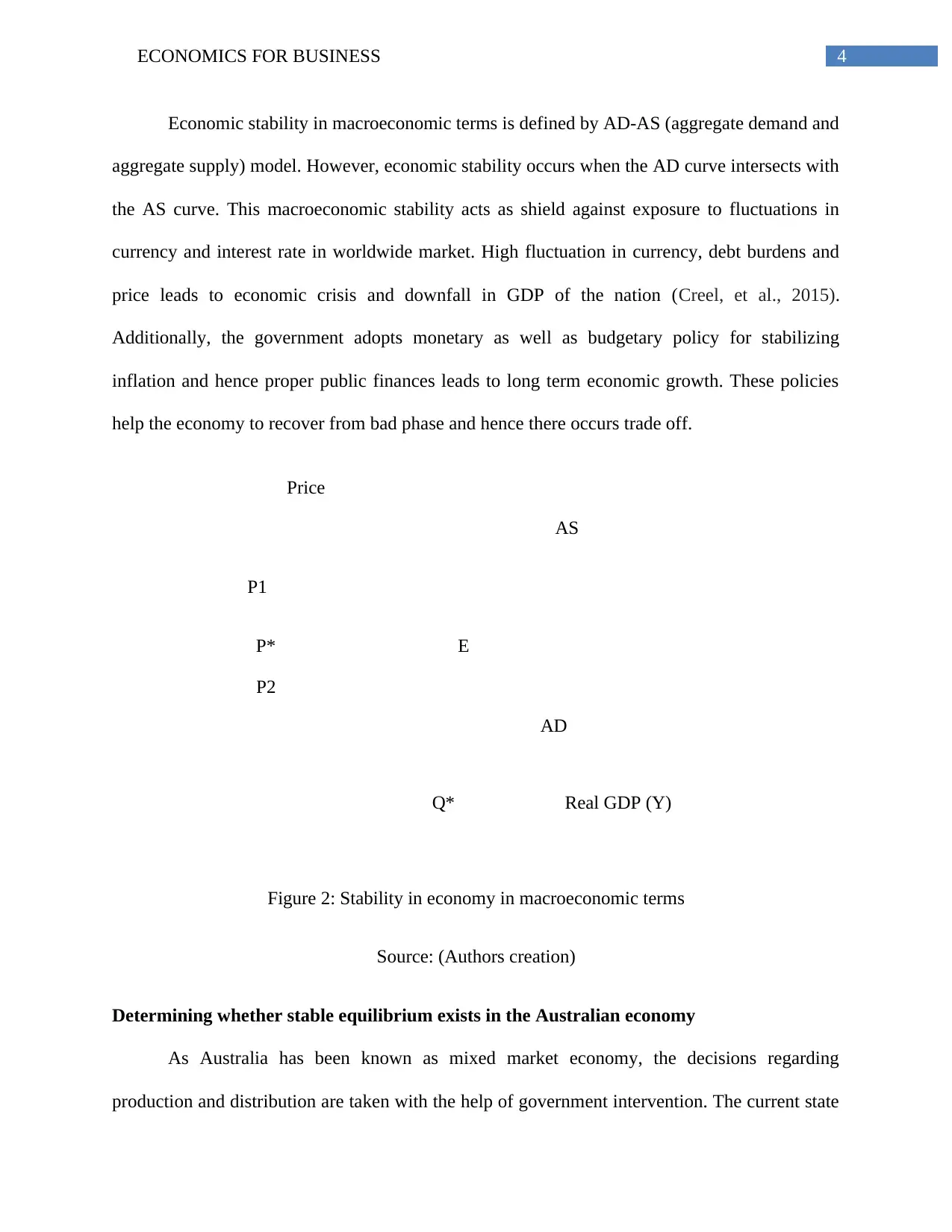
4ECONOMICS FOR BUSINESS
AS
AD
Real GDP (Y)
Price
EP*
Q*
P1
P2
Economic stability in macroeconomic terms is defined by AD-AS (aggregate demand and
aggregate supply) model. However, economic stability occurs when the AD curve intersects with
the AS curve. This macroeconomic stability acts as shield against exposure to fluctuations in
currency and interest rate in worldwide market. High fluctuation in currency, debt burdens and
price leads to economic crisis and downfall in GDP of the nation (Creel, et al., 2015).
Additionally, the government adopts monetary as well as budgetary policy for stabilizing
inflation and hence proper public finances leads to long term economic growth. These policies
help the economy to recover from bad phase and hence there occurs trade off.
Figure 2: Stability in economy in macroeconomic terms
Source: (Authors creation)
Determining whether stable equilibrium exists in the Australian economy
As Australia has been known as mixed market economy, the decisions regarding
production and distribution are taken with the help of government intervention. The current state
AS
AD
Real GDP (Y)
Price
EP*
Q*
P1
P2
Economic stability in macroeconomic terms is defined by AD-AS (aggregate demand and
aggregate supply) model. However, economic stability occurs when the AD curve intersects with
the AS curve. This macroeconomic stability acts as shield against exposure to fluctuations in
currency and interest rate in worldwide market. High fluctuation in currency, debt burdens and
price leads to economic crisis and downfall in GDP of the nation (Creel, et al., 2015).
Additionally, the government adopts monetary as well as budgetary policy for stabilizing
inflation and hence proper public finances leads to long term economic growth. These policies
help the economy to recover from bad phase and hence there occurs trade off.
Figure 2: Stability in economy in macroeconomic terms
Source: (Authors creation)
Determining whether stable equilibrium exists in the Australian economy
As Australia has been known as mixed market economy, the decisions regarding
production and distribution are taken with the help of government intervention. The current state
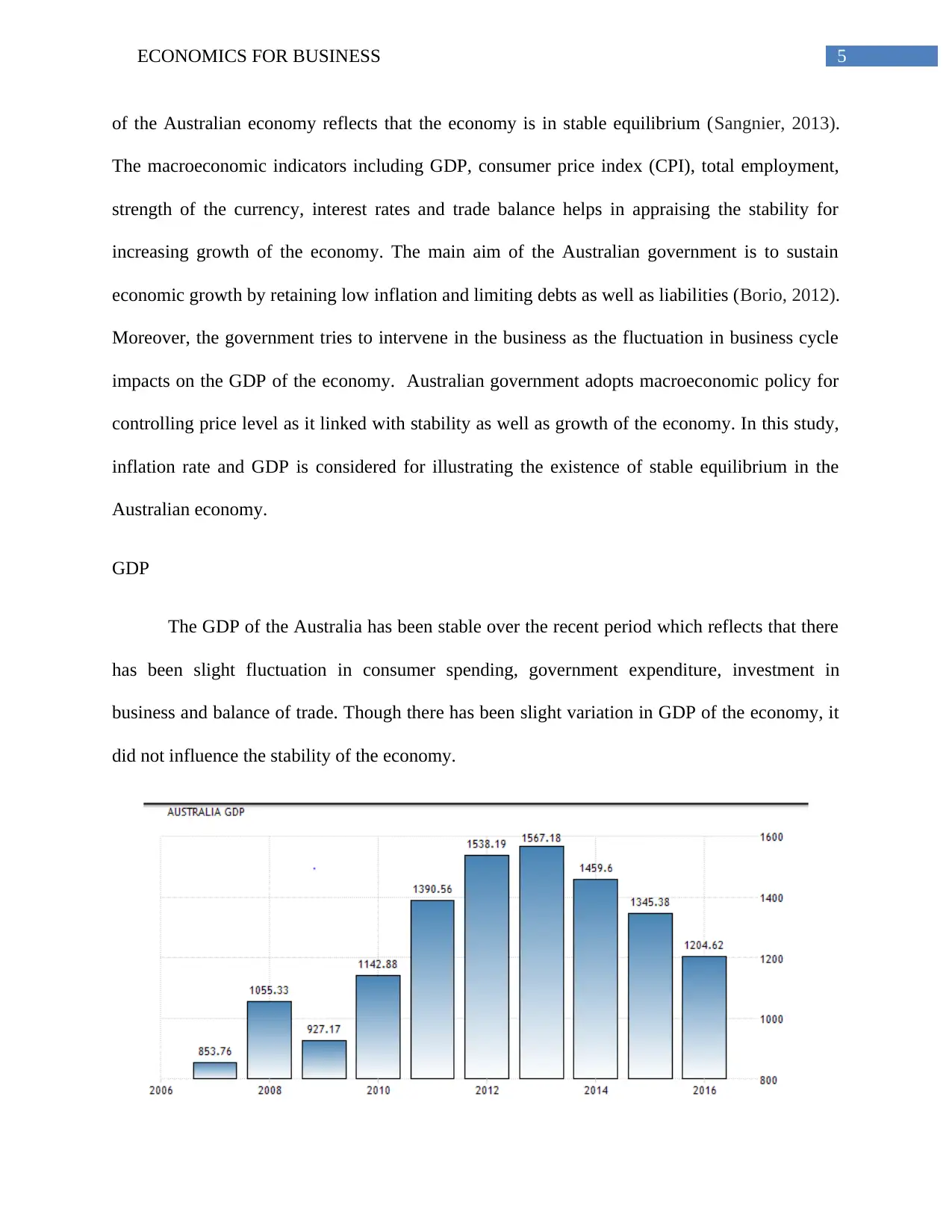
5ECONOMICS FOR BUSINESS
of the Australian economy reflects that the economy is in stable equilibrium (Sangnier, 2013).
The macroeconomic indicators including GDP, consumer price index (CPI), total employment,
strength of the currency, interest rates and trade balance helps in appraising the stability for
increasing growth of the economy. The main aim of the Australian government is to sustain
economic growth by retaining low inflation and limiting debts as well as liabilities (Borio, 2012).
Moreover, the government tries to intervene in the business as the fluctuation in business cycle
impacts on the GDP of the economy. Australian government adopts macroeconomic policy for
controlling price level as it linked with stability as well as growth of the economy. In this study,
inflation rate and GDP is considered for illustrating the existence of stable equilibrium in the
Australian economy.
GDP
The GDP of the Australia has been stable over the recent period which reflects that there
has been slight fluctuation in consumer spending, government expenditure, investment in
business and balance of trade. Though there has been slight variation in GDP of the economy, it
did not influence the stability of the economy.
of the Australian economy reflects that the economy is in stable equilibrium (Sangnier, 2013).
The macroeconomic indicators including GDP, consumer price index (CPI), total employment,
strength of the currency, interest rates and trade balance helps in appraising the stability for
increasing growth of the economy. The main aim of the Australian government is to sustain
economic growth by retaining low inflation and limiting debts as well as liabilities (Borio, 2012).
Moreover, the government tries to intervene in the business as the fluctuation in business cycle
impacts on the GDP of the economy. Australian government adopts macroeconomic policy for
controlling price level as it linked with stability as well as growth of the economy. In this study,
inflation rate and GDP is considered for illustrating the existence of stable equilibrium in the
Australian economy.
GDP
The GDP of the Australia has been stable over the recent period which reflects that there
has been slight fluctuation in consumer spending, government expenditure, investment in
business and balance of trade. Though there has been slight variation in GDP of the economy, it
did not influence the stability of the economy.
⊘ This is a preview!⊘
Do you want full access?
Subscribe today to unlock all pages.

Trusted by 1+ million students worldwide
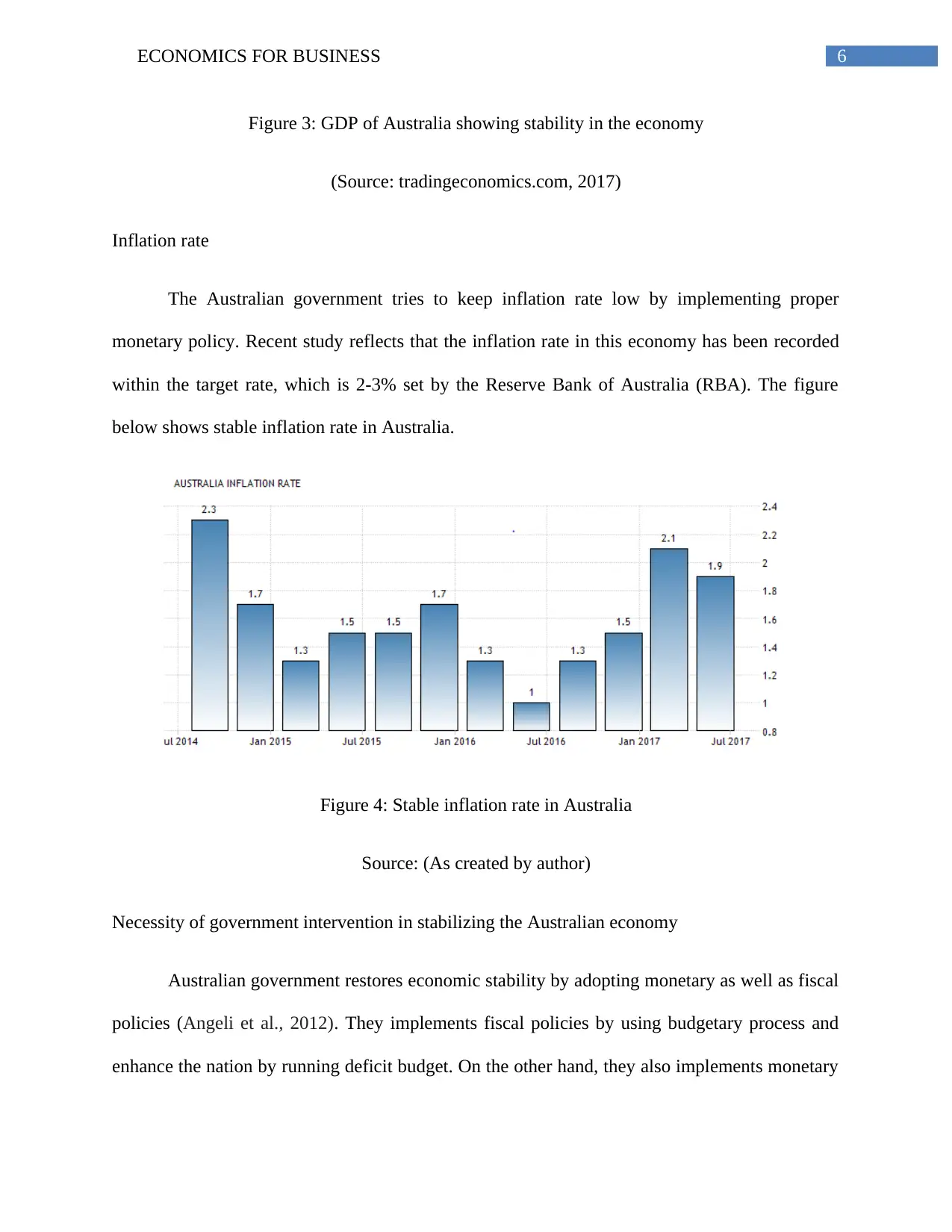
6ECONOMICS FOR BUSINESS
Figure 3: GDP of Australia showing stability in the economy
(Source: tradingeconomics.com, 2017)
Inflation rate
The Australian government tries to keep inflation rate low by implementing proper
monetary policy. Recent study reflects that the inflation rate in this economy has been recorded
within the target rate, which is 2-3% set by the Reserve Bank of Australia (RBA). The figure
below shows stable inflation rate in Australia.
Figure 4: Stable inflation rate in Australia
Source: (As created by author)
Necessity of government intervention in stabilizing the Australian economy
Australian government restores economic stability by adopting monetary as well as fiscal
policies (Angeli et al., 2012). They implements fiscal policies by using budgetary process and
enhance the nation by running deficit budget. On the other hand, they also implements monetary
Figure 3: GDP of Australia showing stability in the economy
(Source: tradingeconomics.com, 2017)
Inflation rate
The Australian government tries to keep inflation rate low by implementing proper
monetary policy. Recent study reflects that the inflation rate in this economy has been recorded
within the target rate, which is 2-3% set by the Reserve Bank of Australia (RBA). The figure
below shows stable inflation rate in Australia.
Figure 4: Stable inflation rate in Australia
Source: (As created by author)
Necessity of government intervention in stabilizing the Australian economy
Australian government restores economic stability by adopting monetary as well as fiscal
policies (Angeli et al., 2012). They implements fiscal policies by using budgetary process and
enhance the nation by running deficit budget. On the other hand, they also implements monetary
Paraphrase This Document
Need a fresh take? Get an instant paraphrase of this document with our AI Paraphraser
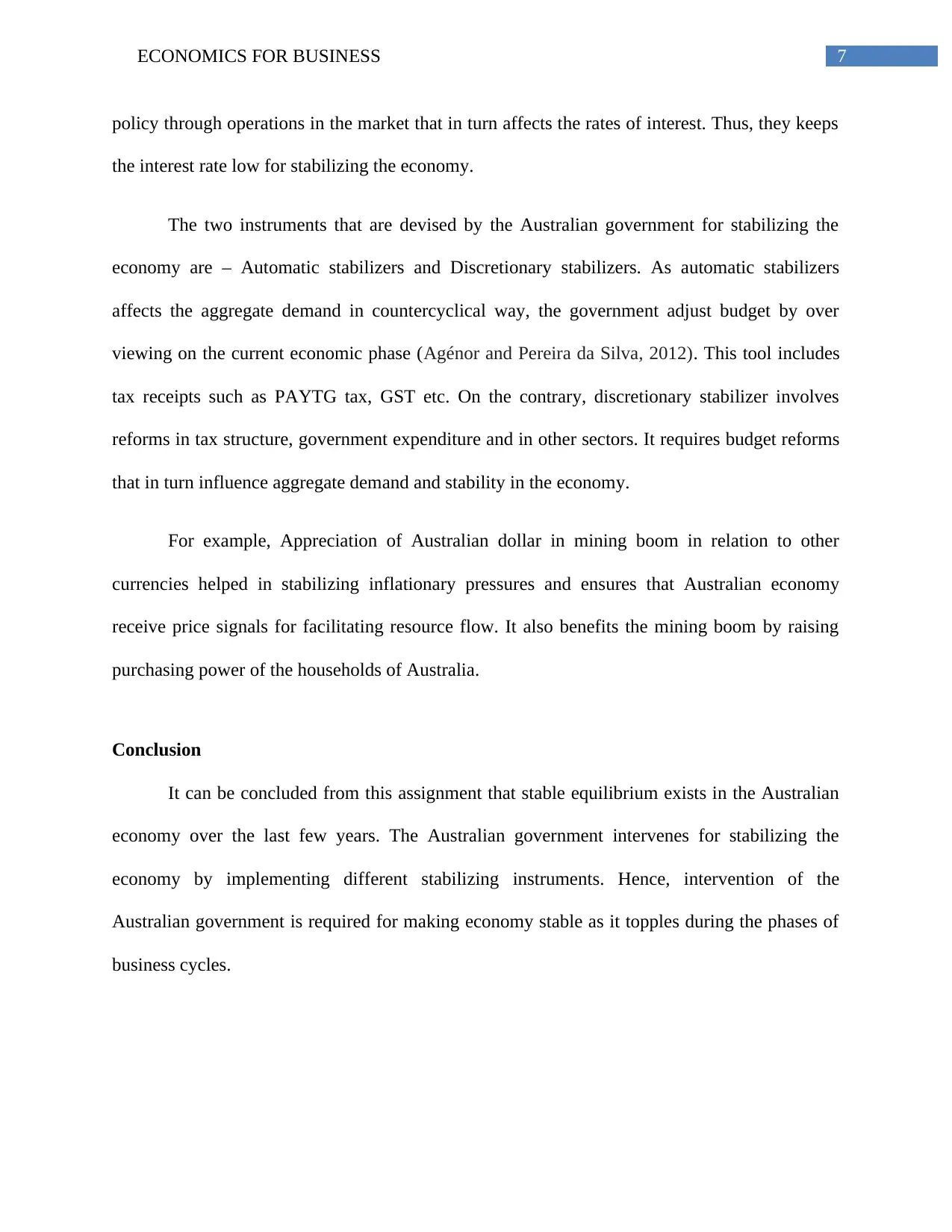
7ECONOMICS FOR BUSINESS
policy through operations in the market that in turn affects the rates of interest. Thus, they keeps
the interest rate low for stabilizing the economy.
The two instruments that are devised by the Australian government for stabilizing the
economy are – Automatic stabilizers and Discretionary stabilizers. As automatic stabilizers
affects the aggregate demand in countercyclical way, the government adjust budget by over
viewing on the current economic phase (Agénor and Pereira da Silva, 2012). This tool includes
tax receipts such as PAYTG tax, GST etc. On the contrary, discretionary stabilizer involves
reforms in tax structure, government expenditure and in other sectors. It requires budget reforms
that in turn influence aggregate demand and stability in the economy.
For example, Appreciation of Australian dollar in mining boom in relation to other
currencies helped in stabilizing inflationary pressures and ensures that Australian economy
receive price signals for facilitating resource flow. It also benefits the mining boom by raising
purchasing power of the households of Australia.
Conclusion
It can be concluded from this assignment that stable equilibrium exists in the Australian
economy over the last few years. The Australian government intervenes for stabilizing the
economy by implementing different stabilizing instruments. Hence, intervention of the
Australian government is required for making economy stable as it topples during the phases of
business cycles.
policy through operations in the market that in turn affects the rates of interest. Thus, they keeps
the interest rate low for stabilizing the economy.
The two instruments that are devised by the Australian government for stabilizing the
economy are – Automatic stabilizers and Discretionary stabilizers. As automatic stabilizers
affects the aggregate demand in countercyclical way, the government adjust budget by over
viewing on the current economic phase (Agénor and Pereira da Silva, 2012). This tool includes
tax receipts such as PAYTG tax, GST etc. On the contrary, discretionary stabilizer involves
reforms in tax structure, government expenditure and in other sectors. It requires budget reforms
that in turn influence aggregate demand and stability in the economy.
For example, Appreciation of Australian dollar in mining boom in relation to other
currencies helped in stabilizing inflationary pressures and ensures that Australian economy
receive price signals for facilitating resource flow. It also benefits the mining boom by raising
purchasing power of the households of Australia.
Conclusion
It can be concluded from this assignment that stable equilibrium exists in the Australian
economy over the last few years. The Australian government intervenes for stabilizing the
economy by implementing different stabilizing instruments. Hence, intervention of the
Australian government is required for making economy stable as it topples during the phases of
business cycles.
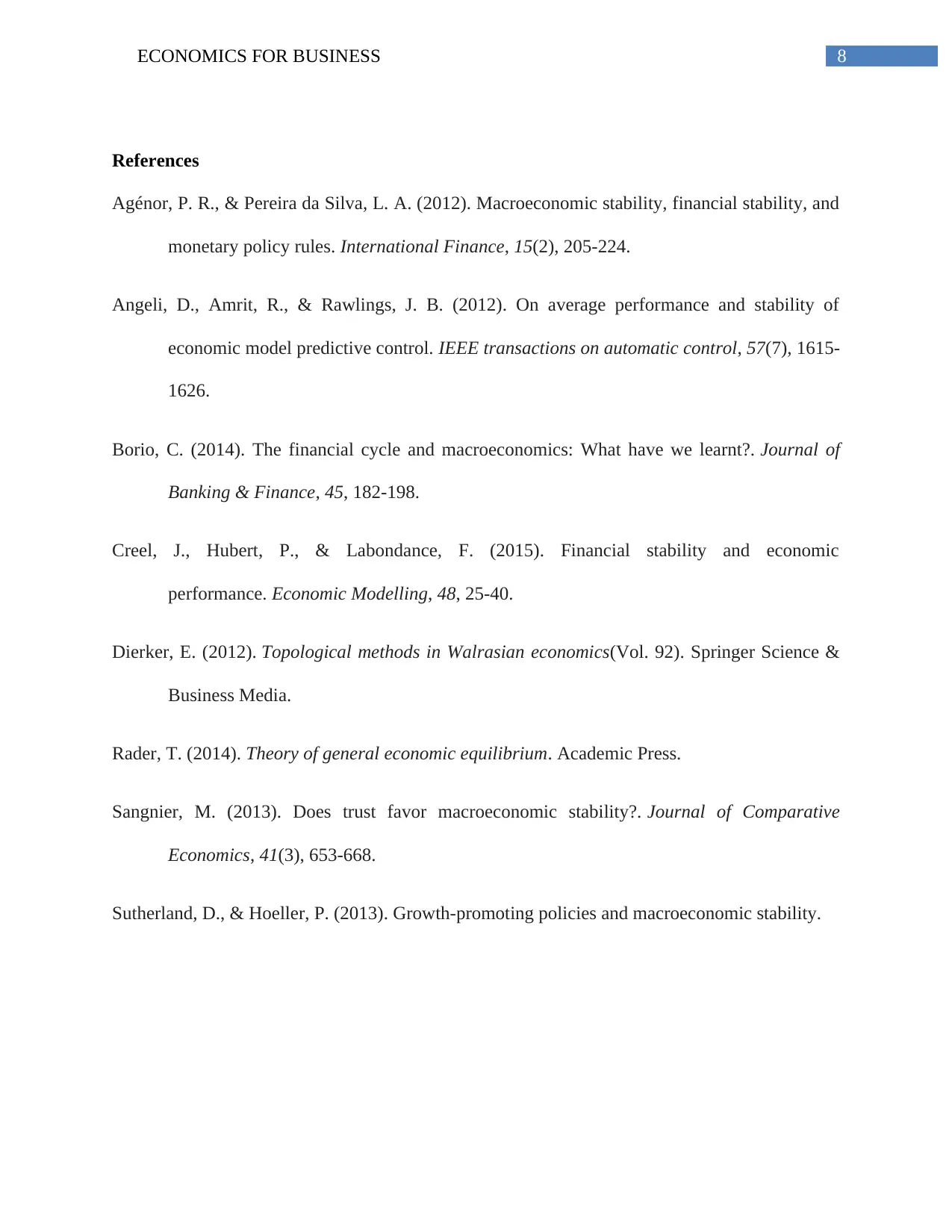
8ECONOMICS FOR BUSINESS
References
Agénor, P. R., & Pereira da Silva, L. A. (2012). Macroeconomic stability, financial stability, and
monetary policy rules. International Finance, 15(2), 205-224.
Angeli, D., Amrit, R., & Rawlings, J. B. (2012). On average performance and stability of
economic model predictive control. IEEE transactions on automatic control, 57(7), 1615-
1626.
Borio, C. (2014). The financial cycle and macroeconomics: What have we learnt?. Journal of
Banking & Finance, 45, 182-198.
Creel, J., Hubert, P., & Labondance, F. (2015). Financial stability and economic
performance. Economic Modelling, 48, 25-40.
Dierker, E. (2012). Topological methods in Walrasian economics(Vol. 92). Springer Science &
Business Media.
Rader, T. (2014). Theory of general economic equilibrium. Academic Press.
Sangnier, M. (2013). Does trust favor macroeconomic stability?. Journal of Comparative
Economics, 41(3), 653-668.
Sutherland, D., & Hoeller, P. (2013). Growth-promoting policies and macroeconomic stability.
References
Agénor, P. R., & Pereira da Silva, L. A. (2012). Macroeconomic stability, financial stability, and
monetary policy rules. International Finance, 15(2), 205-224.
Angeli, D., Amrit, R., & Rawlings, J. B. (2012). On average performance and stability of
economic model predictive control. IEEE transactions on automatic control, 57(7), 1615-
1626.
Borio, C. (2014). The financial cycle and macroeconomics: What have we learnt?. Journal of
Banking & Finance, 45, 182-198.
Creel, J., Hubert, P., & Labondance, F. (2015). Financial stability and economic
performance. Economic Modelling, 48, 25-40.
Dierker, E. (2012). Topological methods in Walrasian economics(Vol. 92). Springer Science &
Business Media.
Rader, T. (2014). Theory of general economic equilibrium. Academic Press.
Sangnier, M. (2013). Does trust favor macroeconomic stability?. Journal of Comparative
Economics, 41(3), 653-668.
Sutherland, D., & Hoeller, P. (2013). Growth-promoting policies and macroeconomic stability.
⊘ This is a preview!⊘
Do you want full access?
Subscribe today to unlock all pages.

Trusted by 1+ million students worldwide
1 out of 9
Related Documents
Your All-in-One AI-Powered Toolkit for Academic Success.
+13062052269
info@desklib.com
Available 24*7 on WhatsApp / Email
![[object Object]](/_next/static/media/star-bottom.7253800d.svg)
Unlock your academic potential
Copyright © 2020–2025 A2Z Services. All Rights Reserved. Developed and managed by ZUCOL.





